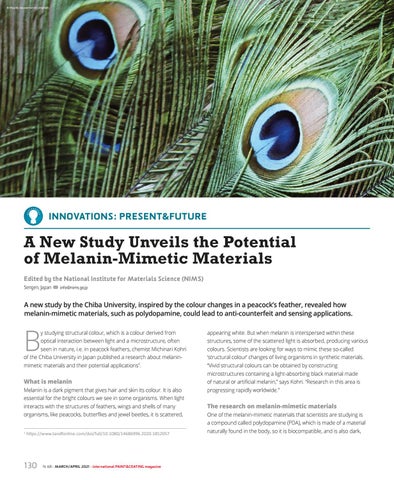© Maurits Bausenhart on Unsplash
INNOVATIONS: PRESENT&FUTURE
A New Study Unveils the Potential of Melanin-Mimetic Materials Edited by the National Institute for Materials Science (NIMS) Sengen, Japan
info@nims.go.jp
A new study by the Chiba University, inspired by the colour changes in a peacock’s feather, revealed how melanin-mimetic materials, such as polydopamine, could lead to anti-counterfeit and sensing applications.
B
y studying structural colour, which is a colour derived from
appearing white. But when melanin is interspersed within these
optical interaction between light and a microstructure, often
structures, some of the scattered light is absorbed, producing various
seen in nature, i.e. in peacock feathers, chemist Michinari Kohri
colours. Scientists are looking for ways to mimic these so-called
of the Chiba University in Japan published a research about melanin-
‘structural colour’ changes of living organisms in synthetic materials.
mimetic materials and their potential applications1.
“Vivid structural colours can be obtained by constructing
What is melanin Melanin is a dark pigment that gives hair and skin its colour. It is also essential for the bright colours we see in some organisms. When light
microstructures containing a light-absorbing black material made of natural or artificial melanin,” says Kohri. “Research in this area is progressing rapidly worldwide.”
interacts with the structures of feathers, wings and shells of many
The research on melanin-mimetic materials
organisms, like peacocks, butterflies and jewel beetles, it is scattered,
One of the melanin-mimetic materials that scientists are studying is a compound called polydopamine (PDA), which is made of a material
1
https://www.tandfonline.com/doi/full/10.1080/14686996.2020.1852057
130
N. 68 - MARCH/APRIL 2021 - international PAINT&COATING magazine
naturally found in the body, so it is biocompatible, and is also dark,
